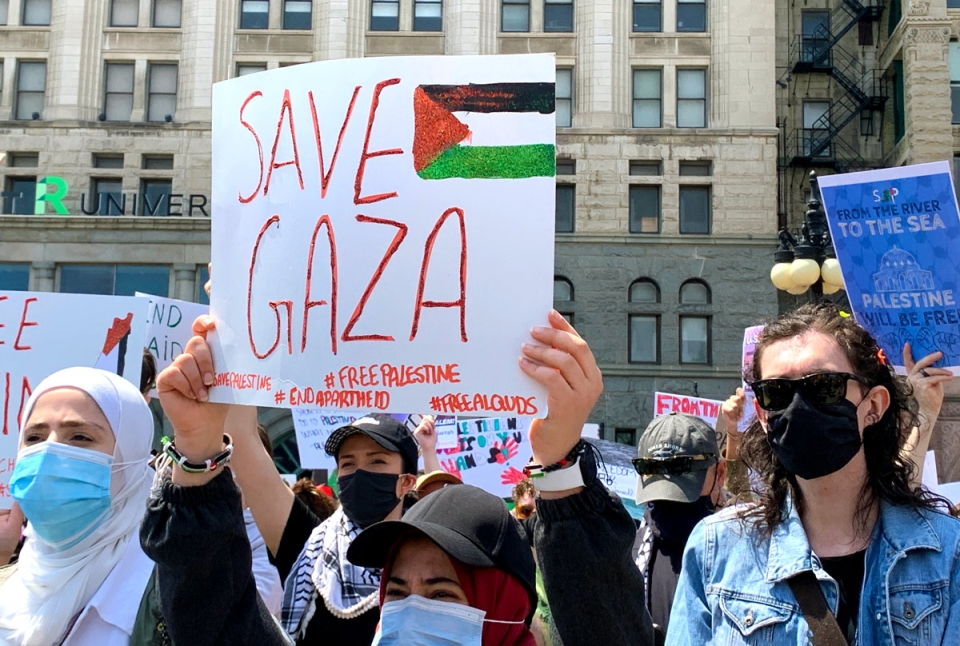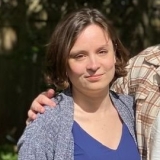
Despite the many challenges, Palestinian youth throughout the occupied Palestinian territory have had opportunities to learn from each other. Photo: Said Huwari / AFSC
In 2013, AFSC started the Palestinian Youth Together for Change (PYTC) program to facilitate connections among Palestinian young adults across walls and militarized borders.
For over 70 years, the Israeli occupation has imposed geographic, political, and social fragmentation of Palestinian communities—in Gaza, the West Bank, and post-1948 Israel. For many PYTC participants, the program is their first opportunity to engage with Palestinians in other parts of historic Palestine.
More than 6,000 Palestinian youth have taken part in PYTC. Although movement restrictions imposed by Israel limit their ability to gather in person, participants learn to work together across divides to address the problems and challenges they face.
Over the past year, PYTC has expanded to include Palestinian youth in Jordan and Lebanon. Together they engage in social and community decision-making—and see more opportunities for unity and hope.
Learn more in this interview with AFSC’s Ali Abdalbari and Serena Awad.
On issues facing youth in Gaza
Serena: In this program, we begin by asking the youth participants to name three of the main issues facing their society. This time, the primary answer that they gave was unemployment—regardless of whether they lived in Gaza, the West Bank, Jordan or Lebanon. While unemployment is high in each of these locations, it is most severe in Gaza. Around 50% of people in Gaza are living under the poverty line, and youth unemployment is over 60%.
Another issue that affects youth in Gaza, in particular, is freedom of movement, as it is extremely difficult to leave the besieged Gaza Strip. Palestinian youth in the West Bank also face obstacles and need permits to travel, but have somewhat more opportunities to go to Jordan, or travel for study or work, than youth in Gaza. For example, the Rafah crossing from Gaza to Egypt is often closed (a U.N. report counted it has been closed for over 100 days in 2022 alone). Even when it is open, it is still not easy to leave. You have to pay around $1,000 for an exit visa to leave the same week that you apply, or $400 if you want to leave that month. These are high prices that most people in Gaza cannot afford.
Another challenge facing youth in Gaza are the Israeli military attacks that prevent them from having a free or safe space to live in Gaza. Many youth are trying their best to leave Gaza permanently.
Ali: Economic issues are also very important for youth, in addition to the political issues and the idea of liberation. Eighty percent of Gaza’s residents depend on food assistance from the international community, so you can imagine the severity of the economic situation. The infrastructure is not able to develop; importing or exporting is very difficult. Everything in Gaza is too expensive for most people to afford.
On finding common ground
Serena: [In coordinating the PYTC program], one problem we face is that youth in Gaza are never able to go to the West Bank and vice versa. And there is such a lack of awareness of conditions on the ground in either place. During one online meeting, youth participants from Gaza were in the AFSC office speaking with youth in the West Bank office. The youth in Gaza did not know what Palestinians in the West Bank are facing—for instance, the reality of having to regularly cross checkpoints in the West Bank. One of the Gazan participants said, in the middle of the conversation, “Oh my God, they seem just like us. They speak the same and even eat the same food, but they don’t have fish.” This shows how little connection they had with Palestinians in the West Bank up until then. It is rewarding to give an opportunity and space for Gazan youth who are unable to go to the West Bank in person, to speak with Palestinians in the West Bank.
One initiative the youth developed together was called “From Gaza to Akka.” It was about looking at the suffering and restrictions facing Palestinian fishermen in both Gaza and Akka, a Palestinian city inside ‘48/Israel proper. The youth didn’t know that Palestinians in Gaza face similar restrictions on fishing to the fishers in Akka. While they saw that the experience is not exactly the same in both locations (for example, the Israeli army doesn’t shoot the fishermen in Akka like they do in Gaza), in both cases, Israel heavily restricts the area where they can fish, and insists that they pay more taxes than Israeli fishermen. It was another eye-opening project for the youth to see the connections between their circumstances.
Ali: In addition to PYTC, we also help to bridge divides among Palestinian youth through our Tawasalo program. The program brings together younger youth from the West Bank and ‘48 Palestinians to talk about identity, stereotypes, and how to overcome fragmentation.
Since COVID, we have created some tools to bring them together through virtual activities and e-games. This summer we brought a group from Gaza to attend a virtual tour with a tour guide from Hebron, in the West Bank. And at the same time, a group from the West Bank attended a virtual tour in Gaza. Then via Zoom, we had both groups talk to each other about the tours, their impressions of the cities, and connecting about each other’s lives.
Both groups asked each other questions about life, the details of their suffering, and about what they have in common. When they started talking to each other, they began to discover themselves. Everybody wanted to talk, to speak about their lives and to ask others about their lives and how they navigate their realities.
On responding to the latest attacks on Gaza
Serena: This year, we started a joint initiative between PYTC and youth in Lebanon and Jordan, with weekly online meetings. During the last attacks on Gaza in August 2022, we had to postpone several of the meetings. Instead, we checked up on the youth in Gaza regularly during the attacks, making sure they were OK and asking if they were in need of any help.
This situation was eye-opening for the youth in Lebanon and Jordan. Many of them previously thought that Israel was just attacking certain people, but the youth in Gaza showed them that this was not the case, that the entire Gaza Strip was subject to attack.
After the August attacks, we began our joint meetings again by just trying to give participants the opportunity to speak with each other. We are working with a psychologist to speak with the group, to let the youth from Gaza express themselves, and to talk about the experiences they have been through.
On mobilizing for a more hopeful future
Ali: People from Gaza in particular, when they are suffering do not have much space to talk, to move even. The siege is not just about economic issues and freedom of movement. It is also reflected mentally. This is true for Palestinians in the West Bank, as well. When Palestinian youth have the chance to speak to each other across these divides, you can see not only hope, but also new spaces for ideas. Even very simple activities create this opening.
Perhaps the best example of youth mobilizing out of hope was the Great March of Return of 2018. During the Great March of Return, tens of thousands of Palestinians in Gaza confronted the Israeli army, in a nonviolent demonstration to demand freedom of movement and an end to the blockade. No one expected the number of youth that made their way to the demonstrations on their own, not by the transportation provided by the political parties. Youth started making their own initiatives throughout the Great March of Return. Even when people are starving, they find the chance to represent their ideas, their identity, and take action. I think this is what gives Palestinians hope today.

